

KNOWLE LOCAL HISTORY SOCIETY
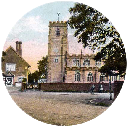
KNOWLE ~ A BRIEF HISTORY
Knowle, spelt Knoll until the mid-19th century, began as a hill-top settlement in the heavily wooded Forest of Arden, encircled by the River Blythe, which has been a significant factor in its history. Originally part of Hampton-in-Arden, Knowle became a separate manor in 1276. Its recorded history begins about 1200, when William de Arden, the Lord of the Manor, gave it to his wife. The oldest part of the village is in the Golden End area of Kenilworth Road. It grew rapidly in the 16th and 17th centuries and many of our timber-framed buildings, including the village inns, date from this period.
The Manor remained with the de Ardens until 1285, when it was bought by King Edward I and Queen Eleanor; but after the Queen’s death in 1290 Edward granted it to Westminster Abbey. After the Reformation it passed through various hands, including Elizabeth I, the Earl of Leicester and James I, who granted it to Fulke Greville in 1623. The Grevilles (later the Earls of Warwick) held it until 1743. In 1773 it came to the Wilsons; but in 1849 William Henry Wilson sold the estate and fled to America to avoid a debtors’ prison. The Everitt family bought the property about 1870 and the Lordship about 1928. They remained until the death of Mr. Horace Everitt in 1982.
The Church, consecrated in 1403, was built because the ford across the River Blythe at Eastcote, which lay between Knowle and its parish church at Hampton-in-Arden, was dangerous in winter. It was founded by Walter Cook, a native of Knowle and a rich and influential cleric of his day. Although ecclesiastically part of Hampton until 1859 it was a parish church in all but name. In 1413 Walter Cook founded the Guild of St. Anne, which became very popular, with most of the local gentry and senior clergy as members. With others he went on to found the College of Knowle in 1416. Both were dissolved and their property confiscated after the Reformation, but the church (not officially a parish church) was saved by the treacherous River Blythe. The Guild House and St. Anne’s Cottage were returned to the Church anonymously in 1912.
Today Knowle is no longer an agricultural village - only one working farm survives. But it is still a desirable place to live. More sensitive planning regulations and better architectural standards now prevail; but problems remain, particularly car parking, the ever growing number of vehicles on the road and - the latest threat - the destruction of good family homes to build multi-storey apartments. Nevertheless the character of the village remains in the Church, the ancient Guild House and other buildings. There is a thriving community spirit, centred around the Church and numerous other organisations catering for all activities. And while well-provided with train and bus services, the lovely countryside is within easy walking distance.
This brief history is also available to download as a leaflet
The Warwick Road was turnpiked in the late 18th century. Knowle became an early stop out of Birmingham on the stage-coach route to London. The Mermaid & Greswolde Arms, newly extended and improved, became the main coaching inn.
The Grand Union Canal, opened in 1799, is famous for its flight of five locks. It now provides an attractive and popular leisure facility for walkers, cyclists, fishermen and boaters. A thriving boatyard occupies the old coal wharf at Kenilworth Road, flanked by moorings. Two pubs are within walking distance.
The Station was opened in 1852, providing a daily train service to London and easier access to Birmingham. Businessmen moved out to the country and commuted to work daily, whilst city dwellers came to Knowle for a day out. Dorridge grew up round the station.
In the Late 19th Century Knowle expanded rapidly. The Victorian school in Kenilworth Road was built in 1871, the Berrow Homes in 1886 and many of our terraced cottages and villas about the same time. But Knowle remained an agricultural village, with many villagers working on the farms or in related businesses. And so life continued until 1914.
During the First World War activities on the home front centred on the Vicarage, with support for the troops vigorously supervised by Canon Downing. The Soldiers’ Chapel was opened in 1921 as a memorial to the 81 young men who never returned. There is a big parade on Remembrance Sunday each year.
Between the Wars there was further expansion: council houses were built in Kixley Lane; Longdon Road, Hampton Road and Tilehouse Green Lane, once country lanes, were lined with new housing. Milverton Road was developed in 1932 and the first few houses on the Wychwood estate, built on the old Glebe Farm, soon followed. In 1939 the demolition of the 15th century White Swan opposite the church, once owned by the College of Knowle, was a tragedy.
The Second World War brought constant air-raids and two bombs fell on Washpits Farm fields; but Knowle was relatively safe. Evacuees arrived from London and elsewhere, whilst the Guild House sheltered people caught in the blitz on Birmingham and Coventry. The village came alive with a bang when a U.S. Army medical unit was stationed here in 1944. On V.E. Day the church was floodlit for the first time.
After the War High Street was zoned for retail use and the surrounding fields for new housing. In 1959 the bulldozers moved in. Many of our timber-framed cottages, unmodernised but reasonably sound, were ruthlessly demolished or left as empty shells with their hearts ripped out, and replaced with ugly modern shops. Village families moved out of Knowle. The Knowle Society was formed in 1962 to protect what remained of our heritage. But it was not all bad: the park was opened in 1960 and the Village Hall in 1961, after a series of fund-raising carnivals. In 1968 High Street was designated as a Conservation Area (since extended). The precinct opened in 1970
In the last thirty years many retail shops have been replaced by offices, estate agents and eating places, whilst farmland west of the village has disappeared under housing estates, with the loss of most of the western footpath network. To the east the Meriden Gap is under constant threat. Opinion on a western relief road is divided, but the opening of the M40 in 1989 provided relief to our traffic-clogged High Street. The Police Station closed in 1972, and the surgery took over the building, providing space for more staff and services. Chester House was converted to a show piece public library in 1975.
The ford at Eastcote, 1915
The church c. 1870
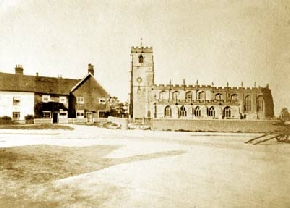
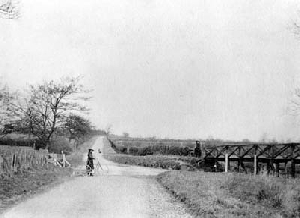

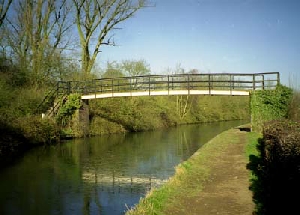
Grand Union Canal
The station, c. 1910
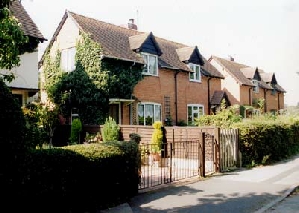
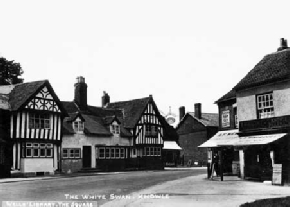
Council houses, Kixley Lane, 2007
The White Swan, demolished in 1939
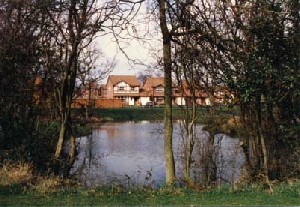
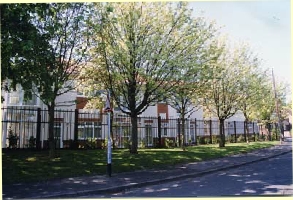
Browns Lane estate, 1987
New flats, 2002